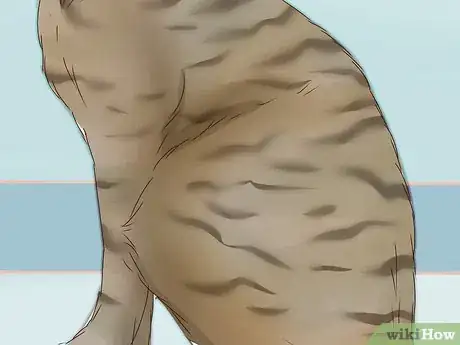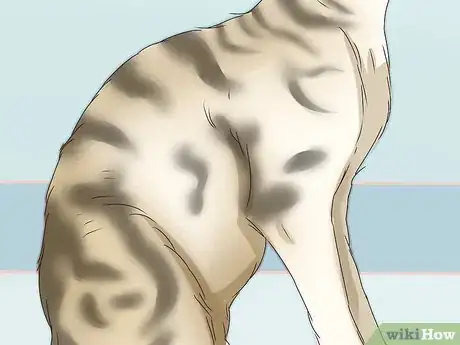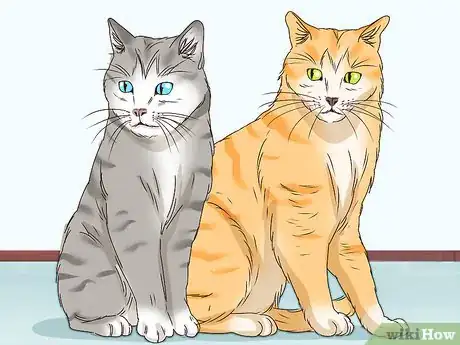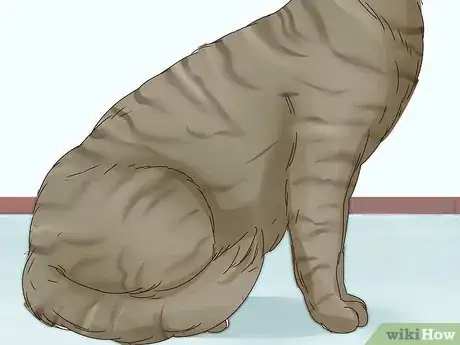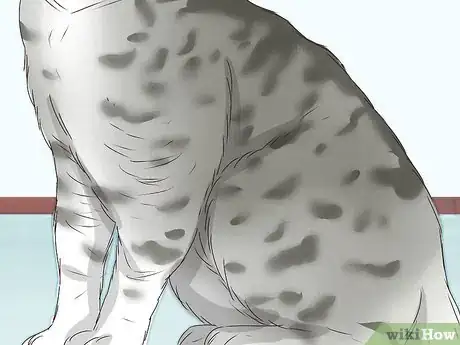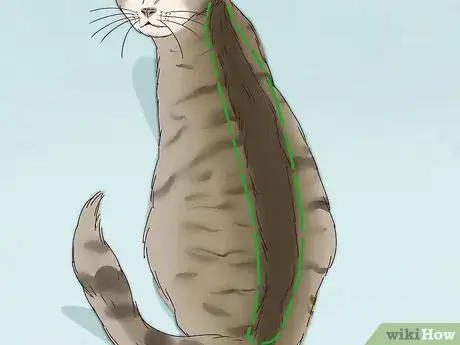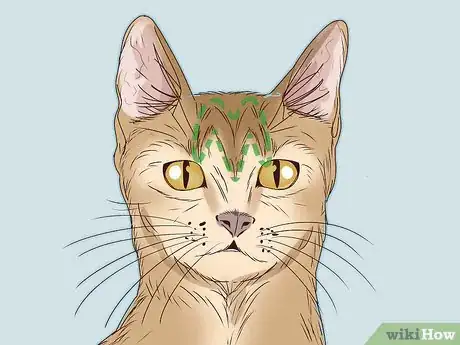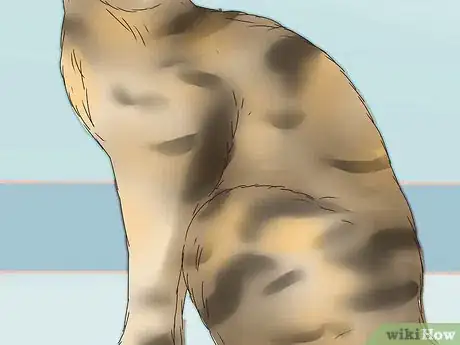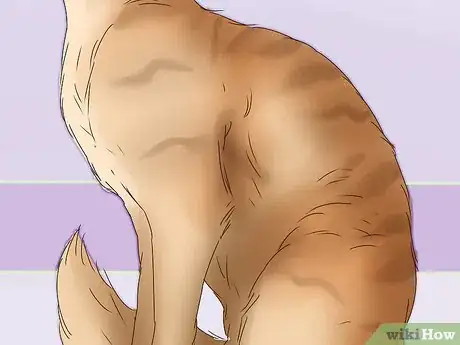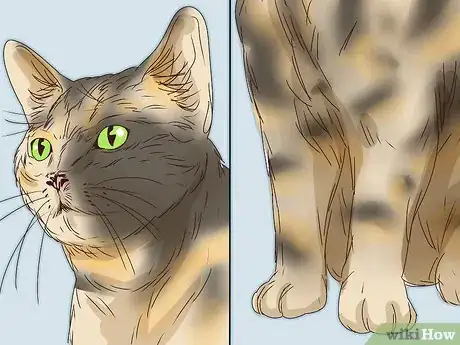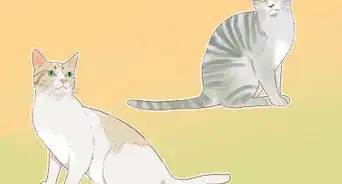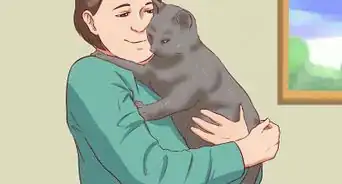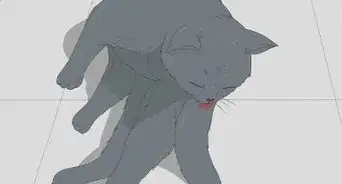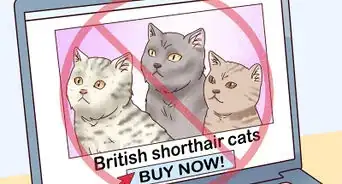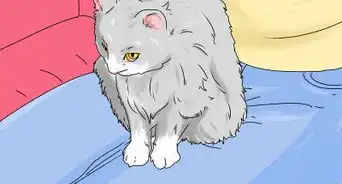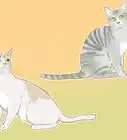This article was co-authored by Pippa Elliott, MRCVS. Dr. Elliott, BVMS, MRCVS is a veterinarian with over 30 years of experience in veterinary surgery and companion animal practice. She graduated from the University of Glasgow in 1987 with a degree in veterinary medicine and surgery. She has worked at the same animal clinic in her hometown for over 20 years.
wikiHow marks an article as reader-approved once it receives enough positive feedback. This article has 16 testimonials from our readers, earning it our reader-approved status.
This article has been viewed 306,678 times.
Tabby cats, sometimes called tiger cats, are not a distinct breed of cat, and as such they do not have any single distinguishing personality or behavioral characteristics. Rather, any cat whose genes express a striped pattern that covers the entire body is considered a tabby cat. The stripes can be thin or thick, straight or swirled, and can be expressed in a variety of different colors. All tabby cats also have a distinct "M" pattern on the forehead, and typically have thin "pencil" lines across the face.[1] Not all cats have tabby patterns, and there are, in fact, five different types of tabby patterns. By learning the basics of pattern identification, you can easily spot a tabby from a non-tabby cat.
Steps
Identifying Classic Tabby Cats
-
1Look for blotchy patterns. Classic tabby cats tend to have blotchy patterns across the body, leading some people to colloquially refer to classic tabbies as "blotched tabbies".[2]
-
2Look for wide stripes. The stripes on a classic tabby cat tend to be wider and thicker than on other varieties of tabbies. Those thicker lines can contribute to the blotchy pattern that is characteristic of classic tabbies.[3]Advertisement
-
3Observe swirling lines. The distinct tabby lines appear circular or swirling on classic tabbies. On some cats they may even resemble a bullseye pattern.[4]
-
4Check the color. Typical tabby cats have black stripes over an otherwise brown coat. Other color variations do occur, but these typically have the qualifying color added before the word tabby, such as a ginger or red tabby (shades of orange and white) or a blue tabby (gray and white).
Identifying Mackerel Tabby Cats
-
1Look for thin stripes. The stripes on a mackerel tabby tend to be very narrow, unlike the wide, swirling stripes of the classic tabby.[5]
-
2Notice the unbroken pattern. Mackerel tabbies typically have unbroken lines that are evenly spaced. These stripes tend to run down both sides of the body in a top-to-bottom formation.[6]
-
3Look at the spine pattern. The most distinct characteristic of mackerel tabbies is the spinal pattern. The stripes that run down the length of the body all extend from a single stripe that covers the cat's spine. Because of the way the cat's body stripes branch off from the spinal stripe, some mackerel tabbies bear a slight resemblance to a fish skeleton, hence the name mackerel.[7]
Identifying Ticked Tabby Cats
-
1Look closely at the hair. Unlike other tabbies, ticked tabby cats do not typically have body stripes. Instead, each individual hair on a ticked tabby has stripes or bands of color variation. This is the tell-tale sign of a ticked tabby.[8]
-
2Look for unmistakable facial patterns. Though ticked tabbies may not look like a typical tabby cat, they still exhibit the same distinct facial patterns. Look for the "M" on the forehead and light pencil marks on either side of the face.[9]
-
3Observe the semi-transparent quality of hair. Not all ticked tabbies have translucent coats, but some, like those in the Abyssinian breed, do have semi-translucent hair.[10]
Identifying Spotted Tabby Cats
-
1Notice the broken lines. Spotted cats earned their name because of the broken lines in their coat patterns. This "broken" coat pattern may cause the lines to appear as spots, though this cat is still very much a tabby.[11]
-
2Observe the variance in spots. The "spots" on the spotted tabby's coat can come in a variety of shapes and sizes. They may be large or small, and may appear to be round, ovular, or rose-shaped.[12]
-
3Don't confuse the spotted tabby and mackerel tabby. Though every spotted tabby's coat will be slightly different, some may be easily confused with a mackerel tabby. Certain spotted tabbies may have "spots" that extend from a spinal stripe, like the mackerel tabby. The difference is that a spotted tabby will still have a more blotchy or spotted appearance.[13]
Identifying Tortoiseshell (Patched) Tabby Cats
-
1Notice blended characteristics. Tortoiseshell/patched tabbies typically have tabby markings combined with another type of coat pattern. Tortoiseshell tabbies may exhibit any of the primary four tabby markings as the tabby component of his coat.[14]
-
2Look for hints of brown and red tabby combined. Your cat is a tortoiseshell tabby if its coat has hair that is definitely ginger in addition to brown tabby spots or stripes.[15]
-
3Observe the legs and head. The telltale tabby markings are typically most prominent on the legs and head of a tortoiseshell tabby cat.[16]
Expert Q&A
Did you know you can get expert answers for this article?
Unlock expert answers by supporting wikiHow
-
QuestionAre tabby cats affectionate?
 Pippa Elliott, MRCVSDr. Elliott, BVMS, MRCVS is a veterinarian with over 30 years of experience in veterinary surgery and companion animal practice. She graduated from the University of Glasgow in 1987 with a degree in veterinary medicine and surgery. She has worked at the same animal clinic in her hometown for over 20 years.
Pippa Elliott, MRCVSDr. Elliott, BVMS, MRCVS is a veterinarian with over 30 years of experience in veterinary surgery and companion animal practice. She graduated from the University of Glasgow in 1987 with a degree in veterinary medicine and surgery. She has worked at the same animal clinic in her hometown for over 20 years.
Veterinarian
-
QuestionWhat is a tabby cat color?
 Pippa Elliott, MRCVSDr. Elliott, BVMS, MRCVS is a veterinarian with over 30 years of experience in veterinary surgery and companion animal practice. She graduated from the University of Glasgow in 1987 with a degree in veterinary medicine and surgery. She has worked at the same animal clinic in her hometown for over 20 years.
Pippa Elliott, MRCVSDr. Elliott, BVMS, MRCVS is a veterinarian with over 30 years of experience in veterinary surgery and companion animal practice. She graduated from the University of Glasgow in 1987 with a degree in veterinary medicine and surgery. She has worked at the same animal clinic in her hometown for over 20 years.
Veterinarian
-
QuestionWhat is the difference between a tiger and a tabby cat?
 Pippa Elliott, MRCVSDr. Elliott, BVMS, MRCVS is a veterinarian with over 30 years of experience in veterinary surgery and companion animal practice. She graduated from the University of Glasgow in 1987 with a degree in veterinary medicine and surgery. She has worked at the same animal clinic in her hometown for over 20 years.
Pippa Elliott, MRCVSDr. Elliott, BVMS, MRCVS is a veterinarian with over 30 years of experience in veterinary surgery and companion animal practice. She graduated from the University of Glasgow in 1987 with a degree in veterinary medicine and surgery. She has worked at the same animal clinic in her hometown for over 20 years.
Veterinarian
References
- ↑ http://www.catster.com/cats-101/tabby-cat
- ↑ http://www.catster.com/cats-101/tabby-cat
- ↑ http://www.petmeds.org/petmeds-spotlight/the-types-of-tabby-coat-patterns/
- ↑ http://www.catster.com/cats-101/tabby-cat
- ↑ http://www.petmeds.org/petmeds-spotlight/the-types-of-tabby-coat-patterns/
- ↑ http://www.catster.com/cats-101/tabby-cat
- ↑ http://www.catster.com/cats-101/tabby-cat
- ↑ http://www.petmeds.org/petmeds-spotlight/the-types-of-tabby-coat-patterns/
- ↑ http://www.catster.com/cats-101/tabby-cat
- ↑ http://www.catster.com/cat-breeds/Abyssinian
- ↑ http://www.petmeds.org/petmeds-spotlight/the-types-of-tabby-coat-patterns/
- ↑ http://www.catster.com/cats-101/tabby-cat
- ↑ http://www.catster.com/cats-101/tabby-cat
- ↑ http://www.petmeds.org/petmeds-spotlight/the-types-of-tabby-coat-patterns/
- ↑ http://www.catster.com/cats-101/tabby-cat
- ↑ http://www.catster.com/cats-101/tabby-cat
About This Article
All tabbies have an “M” pattern on their foreheads and stripes on the sides of their faces, so check the body pattern to determine which specific kind it is. Wide, swirling, somewhat blotchy stripes indicate that it’s a classic tabby, while one thick stripe down the cat’s back with thin, evenly-spaced stripes all the way down the body mean it’s a mackerel tabby. Not all tabbies have stripes, though, so if you notice the “M” on the forehead but none of the telltale stripes on the body, it’s a ticked tabby. To learn how to identify other unconventional cats, like spotted and patched tabbies, keep reading!

